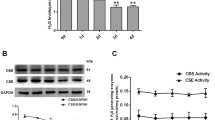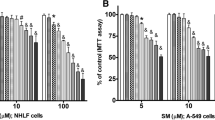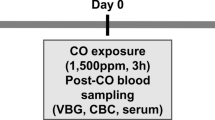Abstract
Sulfur mustard (SM) is a highly toxic war chemical that causes significant morbidity and mortality and lacks any effective therapy. Rats exposed to aerosolized CEES (2-chloroethyl ethyl sulfide; 10% in ethanol), an analog of SM, developed acute respiratory distress syndrome (ARDS), which is characterized by increased inflammation, hypoxemia and impaired gas exchange. We observed elevated levels of extracellular nucleic acids (eNA) in the bronchoalveolar lavage fluid (BALF) of CEES-exposed animals. eNA can induce inflammation, coagulation and barrier dysfunction. Treatment with hexadimethrine bromide (HDMBr; 10 mg/kg), an eNA neutralizing agent, 2 h post-exposure, reduced lung injury, inhibited disruption of alveolar–capillary barrier, improved blood oxygenation (PaO2/FiO2 ratio), thus reversing ARDS symptoms. HDMBr treatment also reduced lung inflammation in the CEES-exposed animals by decreasing IL-6, IL-1A, CXCL-1 and CCL-2 mRNA levels in lung tissues and HMGB1 protein in BALF. Furthermore, HDMBr treatment also reduced levels of lung tissue factor and plasminogen activator inhibitor-1 indicating reduction in clot formation and increased fibrinolysis. Fibrin was reduced in BALF of the HDMBr-treated animals. This was further confirmed by histology that revealed diminished airway fibrin, epithelial sloughing and hyaline membrane in the lungs of HDMBr-treated animals. HDMBr completely rescued the CEES-associated mortality 12 h post-exposure when the survival rate in CEES-only group was just 50%. Experimental eNA treatment of cells caused increased inflammation that was reversed by HDMBr. These results demonstrate a role of eNA in the pathogenesis of CEES/SM-induced injury and that its neutralization can serve as a potential therapeutic approach in treating SM toxicity.








Similar content being viewed by others
References
Abraham E, Arcaroli J, Carmody A, Wang H, Tracey KJ (2000) HMG-1 as a mediator of acute lung inflammation. J Immunol 165(6):2950–2954
Ahmad S, Ahmad A (2016) Emerging targets for treating sulfur mustard-induced injuries. Ann N Y Acad Sci 1374(1):123–131. https://doi.org/10.1111/nyas.13095
Ahmad S, Zafar I, Mariappan N et al (2019) Acute pulmonary effects of aerosolized nicotine. Am J Physiol Lung Cell Mol Physiol 316(1):L94–L104. https://doi.org/10.1152/ajplung.00564.2017
Attaran D, Lari SM, Towhidi M et al (2010) Interleukin-6 and airflow limitation in chemical warfare patients with chronic obstructive pulmonary disease. Int J Chron Obstruct Pulmon Dis 5:335–340. https://doi.org/10.2147/COPD.S12545
Balali-Mood M, Hefazi M (2006) Comparison of early and late toxic effects of sulfur mustard in Iranian veterans. Basic Clin Pharmacol Toxicol 99(4):273–282
Barrat FJ, Meeker T, Gregorio J et al (2005) Nucleic acids of mammalian origin can act as endogenous ligands for Toll-like receptors and may promote systemic lupus erythematosus. J Exp Med 202(8):1131–1139. https://doi.org/10.1084/jem.20050914
Calvet JH, Jarreau PH, Levame M et al (1994) Acute and chronic respiratory effects of sulfur mustard intoxication in guinea pig. J Appl Physiol 76(2):681–688. https://doi.org/10.1152/jappl.1994.76.2.681
Campbell EL, Bruyninckx WJ, Kelly CJ et al (2014) Transmigrating neutrophils shape the mucosal microenvironment through localized oxygen depletion to influence resolution of inflammation. Immunity 40(1):66–77. https://doi.org/10.1016/j.immuni.2013.11.020
Chen W, Janz DR, Shaver CM, Bernard GR, Bastarache JA, Ware LB (2015) Clinical characteristics and outcomes are similar in ARDS diagnosed by oxygen saturation/Fio2 ratio compared With Pao2/Fio2 Ratio. Chest 148(6):1477–1483. https://doi.org/10.1378/chest.15-0169
Chevillard M, Lainee P, Robineau P, Puchelle E (1992) Toxic effects of sulfur mustard on respiratory epithelial cells in culture. Cell Biol Toxicol 8(2):171–181
Das SK, Mukherjee S, Smith MG, Chatterjee D (2003) Prophylactic protection by N-acetylcysteine against the pulmonary injury induced by 2-chloroethyl ethyl sulfide, a mustard analogue. J Biochem Mol Toxicol 17(3):177–184. https://doi.org/10.1002/jbt.10076
Eisenmenger W, Drasch G, von Clarmann M, Kretschmer E, Roider G (1991) Clinical and morphological findings on mustard gas [bis(2-chloroethyl)sulfide] poisoning. J Forensic Sci 36(6):1688–1698
Erjefalt JS, Erjefalt I, Sundler F, Persson CG (1994) Microcirculation-derived factors in airway epithelial repair in vivo. Microvasc Res 48(2):161–178. https://doi.org/10.1006/mvre.1994.1047
Fischer S, Gerriets T, Wessels C et al (2007) Extracellular RNA mediates endothelial-cell permeability via vascular endothelial growth factor. Blood 110(7):2457–2465. https://doi.org/10.1182/blood-2006-08-040691
Gao X, Anderson DR, Brown AW et al (2011) Pathological studies on the protective effect of a macrolide antibiotic, roxithromycin, against sulfur mustard inhalation toxicity in a rat model. Toxicol Pathol 39(7):1056–1064. https://doi.org/10.1177/0192623311422079
Gao W, Xiong Y, Li Q, Yang H (2017) Inhibition of toll-like receptor signaling as a promising therapy for inflammatory diseases: a journey from molecular to nano therapeutics. Front Physiol 8:508. https://doi.org/10.3389/fphys.2017.00508
Garcia-Olmo DC, Ruiz-Piqueras R, Garcia-Olmo D (2004) Circulating nucleic acids in plasma and serum (CNAPS) and its relation to stem cells and cancer metastasis: state of the issue. Histol Histopathol 19(2):575–583. https://doi.org/10.14670/HH-19.575
Gauthier VJ, Tyler LN, Mannik M (1996) Blood clearance kinetics and liver uptake of mononucleosomes in mice. J Immunol 156(3):1151–1156
Gay NJ, Symmons MF, Gangloff M, Bryant CE (2014) Assembly and localization of Toll-like receptor signalling complexes. Nat Rev Immunol 14(8):546–558. https://doi.org/10.1038/nri3713
Gunther A, Mosavi P, Heinemann S et al (2000) Alveolar fibrin formation caused by enhanced procoagulant and depressed fibrinolytic capacities in severe pneumonia. Comparison with the acute respiratory distress syndrome. Am J Respir Criti Care Med 161(2 Pt 1):454–462
Hajizadeh S, DeGroot J, TeKoppele JM, Tarkowski A, Collins LV (2003) Extracellular mitochondrial DNA and oxidatively damaged DNA in synovial fluid of patients with rheumatoid arthritis. Arthritis Res Ther 5(5):R234–R240. https://doi.org/10.1186/ar787
Hassan ZM, Ebtekar M, Ghanei M, Taghikhani M, Noori Daloii MR, Ghazanfari T (2006) Immunobiological consequences of sulfur mustard contamination. Iran J Allergy Asthma Immunol 5(3):101–108
Henretig FM, Kirk MA, McKay CA Jr (2019) Hazardous Chemical Emergencies and Poisonings. N Engl J Med 380(17):1638–1655. https://doi.org/10.1056/NEJMra1504690
Houin PR, Veress LA, Rancourt RC et al (2015) Intratracheal heparin improves plastic bronchitis due to sulfur mustard analog. Pediatr Pulmonol 50(2):118–126. https://doi.org/10.1002/ppul.23043
Idell S (2003) Coagulation, fibrinolysis, and fibrin deposition in acute lung injury. Crit Care Med 31(4 Suppl):S213–S220
Jain S, Pitoc GA, Holl EK et al (2012) Nucleic acid scavengers inhibit thrombosis without increasing bleeding. Proc Natl Acad Sci USA 109(32):12938–12943. https://doi.org/10.1073/pnas.1204928109
Jett DA, Laney JW (2019) Civilian research on chemical medical countermeasures. Toxicol Mech Methods. https://doi.org/10.1080/15376516.2019.1669250
Kehe K, Szinicz L (2005) Medical aspects of sulphur mustard poisoning. Toxicology 214(3):198–209
Kehe K, Thiermann H, Balszuweit F, Eyer F, Steinritz D, Zilker T (2009) Acute effects of sulfur mustard injury–Munich experiences. Toxicology 263(1):3–8
Komissarov AA, Florova G, Idell S (2011) Effects of extracellular DNA on plasminogen activation and fibrinolysis. J Biol Chem 286(49):41949–41962. https://doi.org/10.1074/jbc.M111.301218
Lawton JA, Ghosh P (2003) Novel therapeutic strategies based on toll-like receptor signaling. Curr Opin Chem Biol 7(4):446–451
Lee J, Sohn JW, Zhang Y, Leong KW, Pisetsky D, Sullenger BA (2011) Nucleic acid-binding polymers as anti-inflammatory agents. Proc Natl Acad Sci USA 108(34):14055–14060. https://doi.org/10.1073/pnas.1105777108
Mackman N, Sawdey MS, Keeton MR, Loskutoff DJ (1993) Murine tissue factor gene expression in vivo. Tissue and cell specificity and regulation by lipopolysaccharide. Am J Pathol 143(1):76–84
Matthay MA, Ware LB, Zimmerman GA (2012) The acute respiratory distress syndrome. J Clin Invest 122(8):2731–2740. https://doi.org/10.1172/JCI60331
McClintock SD, Till GO, Smith MG, Ward PA (2002) Protection from half-mustard-gas-induced acute lung injury in the rat. J Appl Toxicol 22(4):257–262. https://doi.org/10.1002/jat.856
McClintock SD, Hoesel LM, Das SK et al (2006) Attenuation of half sulfur mustard gas-induced acute lung injury in rats. J Appl Toxicol 26(2):126–131. https://doi.org/10.1002/jat.1115
McElroy CS, Min E, Huang J et al (2016) From the cover: catalytic antioxidant rescue of inhaled sulfur mustard toxicity. Toxicol Sci 154(2):341–353. https://doi.org/10.1093/toxsci/kfw170
Nakazawa F, Kannemeier C, Shibamiya A et al (2005) Extracellular RNA is a natural cofactor for the (auto-)activation of Factor VII-activating protease (FSAP). Biochem J 385(Pt 3):831–838. https://doi.org/10.1042/BJ20041021
Neudecker V, Brodsky KS, Clambey ET et al (2017) Neutrophil transfer of miR-223 to lung epithelial cells dampens acute lung injury in mice. Sci Transl Med. https://doi.org/10.1126/scitranslmed.aah5360
O'Driscoll L (2007) Extracellular nucleic acids and their potential as diagnostic, prognostic and predictive biomarkers. Anticancer Res 27(3A):1257–1265
Ogawa EN, Ishizaka A, Tasaka S et al (2006) Contribution of high-mobility group box-1 to the development of ventilator-induced lung injury. Am J Respir Crit Care Med 174(4):400–407. https://doi.org/10.1164/rccm.200605-699OC
Pant SC, Vijayaraghavan R (1999) Histomorphological and histochemical alterations following short-term inhalation exposure to sulfur mustard on visceral organs of mice. Biomed Environ Sci 12(3):201–213
Pisetsky DS, Lee J, Leong KW, Sullenger BA (2012) Nucleic acid-binding polymers as anti-inflammatory agents: reducing the danger of nuclear attack. Expert Rev Clin Immunol 8(1):1–3. https://doi.org/10.1586/eci.11.82
Preissner KT (2007) Extracellular RNA. A new player in blood coagulation and vascular permeability. Hamostaseologie 27(5):373–377
Preissner KT, Herwald H (2017) Extracellular nucleic acids in immunity and cardiovascular responses: between alert and disease. Thromb Haemost 117(7):1272–1282. https://doi.org/10.1160/TH-16-11-0858
Rancourt RC, Veress LA, Ahmad A et al (2013) Tissue factor pathway inhibitor prevents airway obstruction, respiratory failure and death due to sulfur mustard analog inhalation. Toxicol Appl Pharmacol 272(1):86–95. https://doi.org/10.1016/j.taap.2013.05.020
Rancourt RC, Ahmad A, Veress LA, Rioux JS, Garlick RB, White CW (2014) Antifibrinolytic mechanisms in acute airway injury after sulfur mustard analog inhalation. Am J Respir Cell Mol Biol 51(4):559–567. https://doi.org/10.1165/rcmb.2014-0012OC
Rice TW, Wheeler AP, Bernard GR et al (2007) Comparison of the SpO2/FIO2 ratio and the PaO2/FIO2 ratio in patients with acute lung injury or ARDS. Chest 132(2):410–417. https://doi.org/10.1378/chest.07-0617
Schultz MJ, Haitsma JJ, Zhang H, Slutsky AS (2006) Pulmonary coagulopathy as a new target in therapeutic studies of acute lung injury or pneumonia–a review. Crit Care Med 34(3):871–877
Sinclair DC (1948) The clinical features of mustard-gas poisoning in man. Br Med J 2(4570):290–294
Sozzi G, Conte D, Leon M et al (2003) Quantification of free circulating DNA as a diagnostic marker in lung cancer. J Clin Oncol 21(21):3902–3908. https://doi.org/10.1200/JCO.2003.02.006
Standiford TJ, Ward PA (2016) Therapeutic targeting of acute lung injury and acute respiratory distress syndrome. Transl Res 167(1):183–191. https://doi.org/10.1016/j.trsl.2015.04.015
Stieger P, Daniel JM, Tholen C et al (2017) Targeting of extracellular RNA reduces edema formation and infarct size and improves survival after myocardial infarction in mice. J Am Heart Assoc 6(6):e004541. https://doi.org/10.1161/JAHA.116.004541
Thompson BT, Chambers RC, Liu KD (2017) Acute Respiratory Distress Syndrome. N Engl J Med 377(6):562–572. https://doi.org/10.1056/NEJMra1608077
Veress LA, O'Neill HC, Hendry-Hofer TB, Loader JE, Rancourt RC, White CW (2010) Airway obstruction due to bronchial vascular injury after sulfur mustard analog inhalation. Am J Respir Crit Care Med 182(11):1352–1361. https://doi.org/10.1164/rccm.200910-1618OC
Veress LA, Hendry-Hofer TB, Loader JE, Rioux JS, Garlick RB, White CW (2013) Tissue plasminogen activator prevents mortality from sulfur mustard analog-induced airway obstruction. Am J Respir Cell Mol Biol 48(4):439–447. https://doi.org/10.1165/rcmb.2012-0177OC
Vijayaraghavan R, Kulkarni A, Pant SC et al (2005) Differential toxicity of sulfur mustard administered through percutaneous, subcutaneous, and oral routes. Toxicol Appl Pharmacol 202(2):180–188. https://doi.org/10.1016/j.taap.2004.06.020
Wang GQ, Xia ZF (2007) Tissue injury by hot fluid containing nitrogen mustard. Burns 33(7):923–926. https://doi.org/10.1016/j.burns.2006.11.004
Weinberger B, Laskin JD, Sunil VR, Sinko PJ, Heck DE, Laskin DL (2011) Sulfur mustard-induced pulmonary injury: therapeutic approaches to mitigating toxicity. Pulm Pharmacol Ther 24(1):92–99. https://doi.org/10.1016/j.pupt.2010.09.004
White CW, Rancourt RC, Veress LA (2016) Sulfur mustard inhalation: mechanisms of injury, alteration of coagulation, and fibrinolytic therapy. Ann N Y Acad Sci 1378(1):87–95. https://doi.org/10.1111/nyas.13130
Wolfson RK, Chiang ET, Garcia JG (2011) HMGB1 induces human lung endothelial cell cytoskeletal rearrangement and barrier disruption. Microvasc Res 81(2):189–197. https://doi.org/10.1016/j.mvr.2010.11.010
Wygrecka M, Morty RE, Markart P et al (2007) Plasminogen activator inhibitor-1 is an inhibitor of factor VII-activating protease in patients with acute respiratory distress syndrome. J Biol Chem 282(30):21671–21682. https://doi.org/10.1074/jbc.M610748200
Yanai H, Taniguchi T (2014) Nucleic acid sensing and beyond: virtues and vices of high-mobility group box 1. J Intern Med 276(5):444–453. https://doi.org/10.1111/joim.12285
Yanai H, Ban T, Wang Z et al (2009) HMGB proteins function as universal sentinels for nucleic-acid-mediated innate immune responses. Nature 462(7269):99–103. https://doi.org/10.1038/nature08512
Yang H, Wang H, Czura CJ, Tracey KJ (2002) HMGB1 as a cytokine and therapeutic target. J Endotoxin Res 8(6):469–472. https://doi.org/10.1179/096805102125001091
Zemans RL, Briones N, Campbell M et al (2011) Neutrophil transmigration triggers repair of the lung epithelium via beta-catenin signaling. Proc Natl Acad Sci USA 108(38):15990–15995. https://doi.org/10.1073/pnas.1110144108
Acknowledgements
This work is supported by National Institutes of Health Office of the Director (NIH OD), the National Institute of Environmental Health Sciences (NIEHS) grant numbers U01ES025069 (AA) and U01ES028182 (SA) and the National Heart Lung and Blood Institute (NHLBI) grant numbers R01HL114933 (AA). VS and KGS are supported by the CAAP program of the Department of Anesthesiology and Perioperative Medicine of the University of Alabama at Birmingham. The authors would also like to thank Stacy Miller, Tara Hendry-Hofer, Jacqueline Rioux, Rhonda Garlick and Joan Loader from the University of Colorado Denver for help in setup of initial studies. The authors are also grateful to Dr. Carl White and Dr. Raymond Rancourt for their valuable advice.
Author information
Authors and Affiliations
Contributions
AA conceived the idea and designed experiments. NM, MH, IZ, VS, SA and AA carried out the experiments, acquired and analyzed data and wrote the manuscript. KS and JFP analyzed data and wrote the manuscript. DRC acquired and analyzed data.
Corresponding author
Ethics declarations
Conflict of interest
A patent application for the use of nucleic acid scavengers in chemical-induced ARDS has been filed (AA). All other authors declare that they have no conflict of interest.
Additional information
Publisher's Note
Springer Nature remains neutral with regard to jurisdictional claims in published maps and institutional affiliations.
Electronic supplementary material
Below is the link to the electronic supplementary material.
Rights and permissions
About this article
Cite this article
Mariappan, N., Husain, M., Zafar, I. et al. Extracellular nucleic acid scavenging rescues rats from sulfur mustard analog-induced lung injury and mortality. Arch Toxicol 94, 1321–1334 (2020). https://doi.org/10.1007/s00204-020-02699-1
Received:
Accepted:
Published:
Issue Date:
DOI: https://doi.org/10.1007/s00204-020-02699-1




